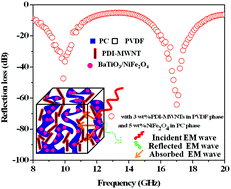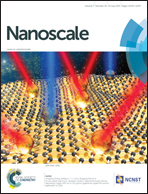Engineering nanostructured polymer blends with controlled nanoparticle location for excellent microwave absorption: a compartmentalized approach
Abstract
In order to obtain better materials, control over the precise location of nanoparticles is indispensable. It is shown here that ordered arrangements of nanoparticles, possessing different characteristics (electrical/magnetic dipoles), in the blend structure can result in excellent microwave absorption. This is manifested from a high reflection loss of ca. −67 dB for the best blend structure designed here. To attenuate electromagnetic radiation, the key parameters of high electrical conductivity and large dielectric/magnetic loss are targeted here by including a conductive material [multiwall carbon nanotubes, MWNTs], ferroelectric nanostructured material with associated relaxations in the GHz frequency [barium titanate, BT] and lossy ferromagnetic nanoparticles [nickel ferrite, NF]. In this study, bi-continuous structures were designed using 50/50 (by wt) blends of polycarbonate (PC) and polyvinylidene fluoride (PVDF). The MWNTs were modified using an electron acceptor molecule, a derivative of perylenediimide, which facilitates π–π stacking with the nanotubes and stimulates efficient charge transport in the blends. The nanoscopic materials have specific affinity towards the PVDF phase. Hence, by introducing surface-active groups, an ordered arrangement can be tailored. To accomplish this, both BT and NF were first hydroxylated followed by the introduction of amine-terminal groups on the surface. The latter facilitated nucleophilic substitution reactions with PC and resulted in their precise location. In this study, we have shown for the first time that by a compartmentalized approach, superior EM attenuation can be achieved. For instance, when the nanoparticles were localized exclusively in the PVDF phase or in both the phases, the minimum reflection losses were ca. −18 dB (for the MWNT/BT mixture) and −29 dB (for the MWNT/NF mixture), and the shielding occurred primarily through reflection. Interestingly, by adopting the compartmentalized approach wherein the lossy materials were in the PC phase and the conductive materials (MWNT) were in the PVDF phase, outstanding reflection losses of ca. −57 dB (for the BT and MWNT combination) and −67 dB (for the NF and MWNT combination) were noted and the shielding occurred primarily through absorption. Thus, the approach demonstrates that nanoscopic structuring in the blends can be achieved under macroscopic processing conditions and this strategy can further be explored to design microwave absorbers.



 Please wait while we load your content...
Please wait while we load your content...